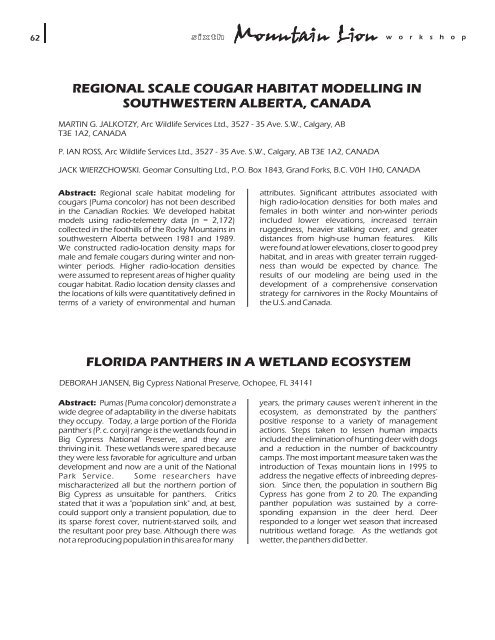PWD BK W7000-893 Proceedings.CDR - Mountain Lion Foundation
PWD BK W7000-893 Proceedings.CDR - Mountain Lion Foundation
PWD BK W7000-893 Proceedings.CDR - Mountain Lion Foundation
Create successful ePaper yourself
Turn your PDF publications into a flip-book with our unique Google optimized e-Paper software.
62<br />
sixth <strong>Mountain</strong> <strong>Lion</strong> w o r k s h o p<br />
REGIONAL SCALE COUGAR HABITAT MODELLING IN<br />
SOUTHWESTERN ALBERTA, CANADA<br />
MARTIN G. JALKOTZY, Arc Wildlife Services Ltd., 3527 - 35 Ave. S.W., Calgary, AB<br />
T3E 1A2, CANADA<br />
P. IAN ROSS, Arc Wildlife Services Ltd., 3527 - 35 Ave. S.W., Calgary, AB T3E 1A2, CANADA<br />
JACK WIERZCHOWSKI. Geomar Consulting Ltd., P.O. Box 1843, Grand Forks, B.C. V0H 1H0, CANADA<br />
Abstract: Regional scale habitat modeling for<br />
cougars (Puma concolor) has not been described<br />
in the Canadian Rockies. We developed habitat<br />
models using radio-telemetry data (n = 2,172)<br />
collected in the foothills of the Rocky <strong>Mountain</strong>s in<br />
southwestern Alberta between 1981 and 1989.<br />
We constructed radio-location density maps for<br />
male and female cougars during winter and nonwinter<br />
periods. Higher radio-location densities<br />
were assumed to represent areas of higher quality<br />
cougar habitat. Radio location density classes and<br />
the locations of kills were quantitatively defined in<br />
terms of a variety of environmental and human<br />
attributes. Significant attributes associated with<br />
high radio-location densities for both males and<br />
females in both winter and non-winter periods<br />
included lower elevations, increased terrain<br />
ruggedness, heavier stalking cover, and greater<br />
distances from high-use human features. Kills<br />
were found at lower elevations, closer to good prey<br />
habitat, and in areas with greater terrain ruggedness<br />
than would be expected by chance. The<br />
results of our modeling are being used in the<br />
development of a comprehensive conservation<br />
strategy for carnivores in the Rocky <strong>Mountain</strong>s of<br />
the U.S. and Canada.<br />
FLORIDA PANTHERS IN A WETLAND ECOSYSTEM<br />
DEBORAH JANSEN, Big Cypress National Preserve, Ochopee, FL 34141<br />
Abstract: Pumas (Puma concolor) demonstrate a<br />
wide degree of adaptability in the diverse habitats<br />
they occupy. Today, a large portion of the Florida<br />
panther's (P. c. coryi) range is the wetlands found in<br />
Big Cypress National Preserve, and they are<br />
thriving in it. These wetlands were spared because<br />
they were less favorable for agriculture and urban<br />
development and now are a unit of the National<br />
Park Service. Some researchers have<br />
mischaracterized all but the northern portion of<br />
Big Cypress as unsuitable for panthers. Critics<br />
stated that it was a "population sink" and, at best,<br />
could support only a transient population, due to<br />
its sparse forest cover, nutrient-starved soils, and<br />
the resultant poor prey base. Although there was<br />
not a reproducing population in this area for many<br />
years, the primary causes weren't inherent in the<br />
ecosystem, as demonstrated by the panthers'<br />
positive response to a variety of management<br />
actions. Steps taken to lessen human impacts<br />
included the elimination of hunting deer with dogs<br />
and a reduction in the number of backcountry<br />
camps. The most important measure taken was the<br />
introduction of Texas mountain lions in 1995 to<br />
address the negative effects of inbreeding depression.<br />
Since then, the population in southern Big<br />
Cypress has gone from 2 to 20. The expanding<br />
panther population was sustained by a corresponding<br />
expansion in the deer herd. Deer<br />
responded to a longer wet season that increased<br />
nutritious wetland forage. As the wetlands got<br />
wetter, the panthers did better.
















